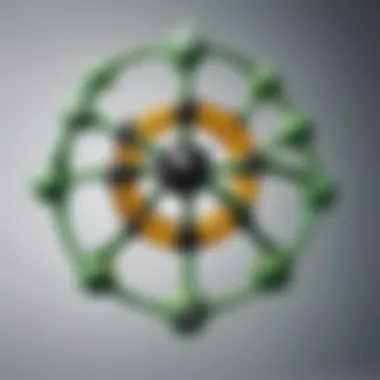Dichloroethane: Applications, Risks, and Regulations


Intro
Dichloroethane, commonly known as DCE, plays a significant role in various industries due to its unique chemical properties. Understanding its usage as a solvent offers insights into both its beneficial applications and potential risks. This article aims to dissect these elements, providing a detailed overview for students, researchers, and industry professionals. The dual nature of DCE as a versatile solvent raises crucial questions about safety and environmental impact. This discourse is increasingly pertinent as regulations evolve to prioritize health and ecological sustainability.
Recent Advances
In recent years, research into dichloroethane has expanded. Several studies focused on its applications, resulting in important findings. Industries such as pharmaceuticals and plastics are key areas where DCE is frequently utilized. Not only does it serve as a solvent, but it also acts as a vital intermediate in the synthesis of various compounds.
Latest Discoveries
Recent discoveries show that DCE may be optimally used to improve the efficiency of certain chemical processes. For instance, in pharmaceutical production, its ability to dissolve a wide range of substances allows for better formulation of medications. Moreover, scientists are investigating its role in recycling plastics, thereby providing a more sustainable solution. This aligns with the changing industrial landscape that seeks to minimize waste and maximize utility.
Technological Innovations
Innovation plays a crucial role in enhancing the effectiveness of DCE as a solvent. Improvements in extraction techniques have resulted in higher yields and purer products. Enhanced distillation methods are also being developed to recover DCE from industrial processes, reducing waste and exposure. Awareness of safer handling methods has increased as well, promoting responsible usage in laboratories and manufacturing plants.
Health Implications
While the benefits of DCE are evident, its potential health risks cannot be ignored. Exposure to dichloroethane has been linked to various health issues, from respiratory problems to long-term effects like liver damage and carcinogenicity. It is essential for professionals to understand these risks and employ necessary safety measures. Regulatory bodies, including the Environmental Protection Agency, continually evaluate the health implications associated with DCE, leading to stricter guidelines and practices.
Epilogue
Foreword to Dichloroethane
Dichloroethane is an important organic solvent with significant utility across various industries. Its unique chemical properties allow it to dissolve a range of substances, making it a valuable component in both industrial and laboratory settings. In this section, we will discuss the fundamental aspects of dichloroethane, examining its structure, types, and the rationale for its widespread use.
Chemically, dichloroethane exists in two isomeric forms, which exhibit different properties and applications. Understanding these variations helps in selecting the appropriate type for specific tasks. Additionally, the balance between its beneficial aspects and the associated health and environmental concerns will be highlighted, ensuring a well-rounded perspective on the topic.
Safe handling and application of dichloroethane are crucial. Awareness of its implications can lead to more informed decision-making among users. This lays the groundwork for exploring in-depth discussions on its properties, industrial applications, and the surrounding concerns, thereby providing a comprehensive overview suited for students, researchers, and professionals alike.
Chemical Structure and Properties
Dichloroethane, represented by the chemical formula C2Cl2, has a relatively simple structure that features two carbon atoms bonded to two chlorine atoms and four hydrogen atoms. This configuration plays a pivotal role in the solvent's distinctive properties. The solvents’ polarity is moderately high, allowing it to dissolve both polar and non-polar substances effectively, which enhances its usefulness in various chemical processes.
Its boiling point is around 83.5 degrees Celsius, and it has a moderate vapor pressure. These properties assure it remains stable under standard laboratory conditions, ensuring reliable performance in a range of applications. Furthermore, dichloroethane’s density is higher than that of water, which signifies that it can easily separate from water in aqueous solutions.
Types of Dichloroethane
Dichloroethane can be categorized mainly into two isomers, each with distinct properties and applications. Understanding their characteristics can greatly influence their function and effectiveness in different contexts.
,1-Dichloroethane
1,1-dichloroethane is distinguished by its molecular structure, where two chlorine atoms are both attached to the same carbon atom. This configuration enhances its reactivity, making it suitable for various synthesis processes. However, this increased reactivity could also lead to instability under certain conditions, raising concerns regarding safe handling and storage. Its relatively high vapor pressure can facilitate quick evaporation, making it effective as a cleaning agent in some industrial processes.
Because of these properties, 1,1-dichloroethane is often favored in chemical syntheses and reaction conditions that require a higher degree of reactivity.
,2-Dichloroethane
In contrast, 1,2-dichloroethane possesses its chlorine atoms attached to different carbon atoms, contributing to a more stable structure. This stability allows it to serve as a more consistent solvent in different applications, such as in the production of polyvinyl chloride (PVC). Its relatively lower reactivity compared to 1,1-dichloroethane makes it a safer choice in many contexts, although it is still critical to manage exposure risk.
The characteristics of 1,2-dichloroethane make it a popular choice in various sectors, including pharmaceuticals and agriculture, where it is valued for its solvent properties while balancing health and environmental concerns effectively.
"Understanding the distinctions between these isomers is essential for optimal application of dichloroethane."


Recognizing the attributes and potential risks tied to both types arms users with the knowledge to make prudent choices regarding their application in industry and research.
Historical Context and Development
The historical context of dichloroethane (DCE) is significant in understanding its role as a solvent in contemporary applications. Not only does it provide insight into the chemical's development but also sheds light on industrial reliance on this compound. This section will unravel the journey of DCE from its discovery to its various uses in multiple industries. Understanding the evolution of DCE showcases its importance in chemical processes and aids discussions around its benefits and concerns.
Discovery and Early Uses
Dichloroethane was first synthesized in the late 19th century. Its early uses remained modest as industries were just beginning to explore the potential of chlorinated solvents. The compound was initially adopted in laboratories for organic synthesis. Its low boiling point and chemical stability made it useful for specific reactions and processes. In those times, the focus was primarily on its chemical properties like its ability to dissolve organic compounds, rather than on its environmental or health impacts.
Over the years, dichloroethane was also utilized in the development of various products. For instance, it played a role in the creation of chemicals required for the synthesis of other important industrial compounds. Early industries embraced DCE more broadly with time, although it was under less scrutiny than it is today.
Evolution of Industrial Applications
As industrial applications evolved, the utilization of dichloroethane experienced a significant increase. Particularly from the mid-20th century onward, its role in the production of polyvinyl chloride (PVC) became notable. This expansion was tied to the ever-growing demand for PVC in a variety of sectors, including construction and packaging.
In the pharmaceutical realm, DCE emerged as a solvent for the synthesis of a range of drugs and agrochemicals. Its performance in dissolving various compounds made it an appealing choice in complex formulations. As technology advanced, industries began to recognize the advantages of DCE, such as its effectiveness in facilitating reactions and separating mixtures.
The timeline from discovery to current industrial applications reveals not only the compound's chemical potential but also illuminates the need for regulation and scrutiny. As more industries adopted its use, concerns about health hazards and environmental impacts also emerged alongside. This evolution ultimately paved the way for the discussions we have today about the safety and sustainability of dichloroethane.
Industrial Applications of Dichloroethane
Dichloroethane is a significant solvent in various industrial settings. Its applications range from organic synthesis to the production of essential materials, showcasing its versatility and importance in modern chemical processes. Investigating the practical utility of DCE offers insights into why it remains a relevant player in numerous sectors despite the ongoing discussion about health and environmental concerns.
Use in Organic Synthesis
Dichloroethane plays a crucial role in organic synthesis, serving as a solvent that facilitates chemical reactions. Its polar aprotic nature allows for the dissolution of a wide range of organic compounds. This characteristic is valuable in executing bimolecular nucleophilic substitution reactions, commonly known as SN2 reactions.
Using DCE increases the reaction rates and improves the yields of many syntheses. For instance, the reagent is often employed in the synthesis of pharmaceuticals and fine chemicals, where precision is necessary. Given that DCE does not form strong hydrogen bonds, it can enhance solubility for various reactants, making it a preferred choice. The ability to dissolve both polar and nonpolar substances broadens its applicability, allowing for diverse chemical transformations in laboratories and industrial environments.
DCE in the Production of PVC
One of the most notable industrial applications of dichloroethane is its role in the production of polyvinyl chloride (PVC). DCE serves as a key intermediate in synthesizing vinyl chloride monomer, which is the building block for PVC manufacturing. This polymer is prevalent in numerous products due to its durability and versatility.
The PVC industry heavily relies on dichloroethane, as the reaction conditions and the solvent's properties directly affect the efficiency of vinyl chloride production. In recent years, advancements have improved the processes involved, ensuring higher purity and efficiency. However, it's important to note that while DCE contributes to PVC production, the environmental impacts of its usage are subject to strict scrutiny due to potential emissions and waste concerns.
Role in Pharmaceuticals and Agrochemicals
Dichloroethane finds extensive use in the pharmaceuticals and agrochemicals industries. Its ability to dissolve a wide array of compounds makes it well-suited for various chemical processes required in drug formulation and agricultural products. This solvent can improve the solubility of active ingredients, which is a critical factor in the effectiveness of pharmaceuticals. Furthermore, the synthesis of several agrochemicals relies on dichloroethane as a reaction medium.
Many drugs and agricultural chemicals would not achieve the necessary bioactivity without effective solvent systems. Consequently, DCE is often included in safety data sheets, directing companies to prioritize careful handling and disposal practices due to its potential health risks. Its role in these sectors demonstrates how critical dichloroethane is, even as alternatives are explored.
The applications of dichloroethane in various industrial processes underline its significance despite environmental challenges and health concerns.
Through its diverse utility, from organic synthesis to industrial manufacturing, dichloroethane continues to be central to many sectors. Balancing its advantages with the potential risks will be essential in securing its future in industrial applications.
Health Risks Associated with DCE
Understanding the health risks associated with dichloroethane (DCE) is essential. This section delves into the toxicological profile and exposure pathways of DCE, highlighting the significance of these topics for both professionals and the general public. Given the widespread applications of DCE, its safety profile must be thoroughly assessed to mitigate potential health concerns.
Toxicological Profile
The toxicological profile of dichloroethane reveals various health effects that can arise from exposure. DCE has been classified as a potential human carcinogen by the Environmental Protection Agency (EPA). Short-term exposure can lead to symptoms such as dizziness, headaches, and irritation of the skin and eyes. Chronic exposure has more severe implications, including damage to the liver and kidneys.


Some key elements of the toxicological profile include:
- Carcinogenicity: Studies suggest a link between high levels of DCE exposure and an increased risk of developing certain types of cancer.
- Neurotoxicity: DCE can affect the nervous system, leading to both acute and chronic neurological issues.
- Reproductive and Developmental Effects: Animal studies indicate potential reproductive risks and developmental abnormalities when exposed to DCE during pregnancy.
These factors highlight the importance of handling DCE with care and adhering to safety guidelines to limit exposure risks.
Exposure Pathways
Exposure pathways describe how individuals may come into contact with dichloroethane. Understanding these pathways is crucial in assessing potential risks and implementing protective measures. Common exposure routes include inhalation, dermal contact, and ingestion.
- Inhalation: DCE vapors can enter the body through the respiratory tract, particularly in industrial settings where DCE is used as a solvent. Poor ventilation can exacerbate this exposure.
- Dermal Contact: Handling DCE without proper protective equipment can lead to skin absorption. This is particularly a concern for workers in laboratories or manufacturing scenarios.
- Ingestion: Accidental ingestion can occur, although this pathway is less common. It can happen through contaminated food or water—another reason to ensure regulatory compliance in waste disposal.
Overall, the potential health risks associated with DCE underscore the need for strict adherence to safety protocols.
"A comprehensive understanding of exposure pathways allows for better risk management and health protection strategies."
This section forms a vital part of the conversation around DCE, establishing the need for further research and regulatory oversight.
Environmental Concerns Regarding DCE
The discussion surrounding dichloroethane (DCE) extends beyond its industrial usage. Environmental concerns form a critical part of this narrative, as the implications of DCE extend to ecosystems and public health. Understanding these elements is essential to gauge the full picture of DCE's impact. Key concerns include contamination of soil and water supplies, as well as challenges to air quality. These issues warrant careful analytical examination due to their long-term effects on both the environment and human health.
Impact on Soil and Water
DCE is prone to leakages and spills, which can lead to significant contamination of soil and water. The compound is highly soluble, allowing it to migrate swiftly into groundwater, creating potential hazards. This poses risks not only to aquatic life but also to human populations relying on these sources for drinking water.
Research has indicated that even minimal concentrations of DCE in water can lead to adverse health effects. These can include headaches, dizziness, and more severe long-term consequences such as liver and kidney damage. Furthermore, soil contamination can disrupt agricultural practices, affecting crop quality and yield due to toxic accumulation.
In summary, effective management of DCE is crucial to preventing its degradation of vital resources. Local regulations and monitoring programs should focus on identifying and mitigating contamination incidents promptly.
Air Quality Issues
The use of DCE also raises air quality concerns. During industrial processes, DCE can evaporate and enter the atmosphere, contributing to air pollution. This poses risks to human health as exposure to airborne DCE can occur through inhalation. Short-term exposure may lead to respiratory issues and other health concerns, while long-term inhalation can have cumulative effects which are harder to quantify.
Additionally, DCE emissions contribute to the formation of ground-level ozone, a key component of smog. This has wider implications for urban areas, where air quality is already a pressing issue. The increase in volatile organic compounds (VOCs) due to DCE can exacerbate pre-existing pollution levels, challenging efforts to improve environmental quality.
"Addressing the environmental consequences of DCE requires multidisciplinary cooperation, leveraging advances in technology and regulatory frameworks."
Therefore, addressing these air quality issues requires not only stringent regulatory measures but also the investment in innovative solutions aimed at reducing DCE emissions across various industrial sectors.
Regulatory Frameworks Governing DCE
The management of dichloroethane (DCE) requires robust regulatory frameworks. These guidelines are essential for ensuring safety, protecting human health, and minimizing environmental impact. The effective regulation of DCE not only safeguards individuals involved in its production and use but also mitigates broader ecological consequences.
Dichloroethane is classified as a hazardous chemical. Therefore, regulatory oversight plays a critical role in its lifecycle, from manufacture to application. Regulation ensures that manufacturers comply with safety standards, thereby reducing the risk of exposure and promoting responsible usage in industrial settings. Furthermore, by understanding these frameworks, stakeholders can make informed decisions regarding the use of DCE.
Global Regulatory Bodies and Guidelines
Various international organizations oversee the regulation of chemicals like DCE. Key bodies include the World Health Organization (WHO) and the United Nations Environment Programme (UNEP). These organizations develop guidelines that member countries can adopt to manage the risks associated with DCE.
Specific regulations such as the Globally Harmonized System of Classification and Labelling of Chemicals (GHS) provide a framework for classifying chemicals based on their health and environmental risks. The GHS stipulates criteria for classification, standard labels, and safety data sheets that inform users about safe handling and potential hazards associated with dichloroethane.
Additionally, the Organization for Economic Co-operation and Development (OECD) promotes cooperative approaches to chemical safety, including thorough testing guidelines for substances like DCE. Through harmonization of assessment procedures, global regulatory bodies aim to streamline chemical safety while fostering international trade.


National Regulations and Compliance
At the national level, many countries have established specific regulations governing the use of DCE. For instance, in the United States, the Environmental Protection Agency (EPA) implements the Toxic Substances Control Act (TSCA), which requires reporting, record-keeping, and testing of certain chemicals, including DCE. Compliance with such regulations is vital for manufacturers and industries that utilize this solvent.
Countries in the European Union follow the Registration, Evaluation, Authorisation and Restriction of Chemicals (REACH) regulation. This legislation ensures that chemicals do not adversely affect human health or the environment. It mandates registration of chemicals and authorizes their use based on a risk assessment process. Nations must ensure that companies using DCE fulfill compliance obligations under these legislative frameworks to prevent hazardous exposure and ensure sustainability.
The interaction between global and national regulatory frameworks represents a complex web of safety standards. Each layer serves to enhance understanding, enforce compliance, and ultimately foster responsible usage of dichloroethane across various sectors.
Alternatives to Dichloroethane
The search for alternatives to dichloroethane (DCE) is increasingly relevant as industries shift towards more sustainable practices. DCE, while effective, poses various health and environmental concerns. Therefore, identifying or developing substitutes that offer similar, if not superior, functional properties while minimizing risks is crucial.
Emerging Green Solvents
Emerging green solvents provide a promising direction for replacing DCE. These solvents often come from renewable resources and aim to reduce toxicity and environmental impact. Some noteworthy examples include:
- Ethyl Lactate: Derived from corn, this solvent is biodegradable, making it an attractive alternative. It's effective for cleaning and can often be used in similar applications as DCE.
- Acetone: While not a green solvent in the traditional sense, its low toxicity and high volatility can present a safer choice for certain applications.
- Lactic Acid: This has gained attention due to its renewability and effectiveness in polymer applications. It's also less harmful to health compared to DCE.
These alternatives not only reduce the health risks associated with DCE but also contribute to more eco-friendly industrial processes.
Comparative Analysis of Solvent Efficacy
When evaluating alternatives to dichloroethane, a comparative analysis of solvent efficacy is necessary. This involves looking at various factors such as solubility, evaporation rate, and the overall environmental impact. Key points to consider include:
- Solubility: Solvents must effectively dissolve necessary compounds in processes like extraction. Ethyl lactate, for example, often matches or surpasses DCE in solubility for various organic compounds.
- Volatility and Stability: Some alternative solvents may have different evaporation rates. Solvents with higher volatility may require more careful handling but often lead to safer working environments.
- Toxicity: The toxicity profiles of alternatives should be critically assessed. It’s vital to ensure that substitutes do not introduce new health risks.
- Cost-effectiveness: Analyzing the economic viability of alternatives is essential. Some green solvents, while safer, may be more expensive, influencing their adoption in industry.
Future Prospects of DCE in Industry
The future of dichloroethane (DCE) as a solvent in various industries will hinge on multiple evolving factors. The prospects revolve around technological innovations, regulatory shifts, and market dynamics that are increasingly impacting its application and acceptance. By exploring these factors, we can glean insights into how DCE might adapt to changing industrial needs and environmental concerns.
Technological Innovations
Technological advancements will play a crucial role in shaping the future use of DCE. For instance, the development of more efficient production methods can lead to lower emissions and reduced waste associated with DCE manufacturing. Technology can also enable the refinement of DCE using advanced purification techniques, mitigating some of the health risks currently associated with the solvent. Moreover, integrating DCE in processes that utilize recovery systems can ensure a more sustainable operational model, effectively reducing reliance on large volumes of raw materials and promoting recycling within chemical industries.
Emerging technologies, such as green chemistry principles, may also give birth to more eco-friendly approaches using DCE. The application of DCE in conjunction with biocatalysts or integrating it into closed-loop systems could result in reduced environmental impact. Companies may invest in research focusing on DCE’s role in solvent recovery, thereby enhancing its recyclability and opening pathways for innovative applications.
Market Trends and Demand Forecasts
Market trends indicate fluctuating yet potentially resilient demand for DCE across various sectors. The ongoing reliance on DCE in the textiles, adhesives, and plastic industries reveals its significant role as an industrial solvent. Given the increasing regulatory focus on health and environmental safety, there may be a shift in demand towards more environmentally friendly solvents. However, this does not eliminate the possibility of DCE remaining a crucial player in solvent applications due to its chemical properties and effectiveness.
Demand forecasts suggest that while there might be pressures to replace DCE, the solvent's unique characteristics make it difficult to substitute entirely. For example, in the production of polyvinyl chloride (PVC), DCE remains an indispensable medium due to its ability to dissolve certain polymers effectively. Thus, while alternatives may penetrate the market, DCE is unlikely to become obsolete immediately.
Furthermore, the global expansion of pharmaceuticals, particularly in emerging markets, underscores the continued relevance of DCE. As research and development efforts intensify, the need for efficient solvents in compound synthesis will likely sustain DCE's application, albeit with closer scrutiny regarding safety practices.
Ending
The conclusion of the article serves as a crucial synthesis that encapsulates the intricate dynamics of dichloroethane (DCE) as a solvent. Understanding the relevance of DCE is paramount, particularly due to its widespread use in various industries and the accompanying health and environmental concerns. By summarizing the previous sections, readers can appreciate the myriad applications of DCE while simultaneously grappling with the inherent risks associated with its use.
Summary of Key Points
In this comprehensive guide, several key points emerge about dichloroethane, including:
- Chemical Properties: DCE's unique molecular structure allows it to function effectively as a solvent in industrial processes. Its polar nature and ability to dissolve a wide range of organic compounds make it invaluable in many applications.
- Industrial Uses: DCE is prominently used in organic synthesis, the production of polyvinyl chloride (PVC), and in the pharmaceutical industry. Its role in the synthesis of various chemicals showcases its importance in modern manufacturing.
- Health Risks: Exposure to DCE can pose serious health risks. The toxicological profile of DCE outlines potential hazards, such as impacts on the central nervous system and skin irritation, which necessitates adherence to strict safety protocols.
- Environmental Impact: DCE's effect on soil, water, and air quality raises significant concerns. The environmental ramifications of its usage prompt discussions about the need for careful regulatory frameworks.
- Regulatory Considerations: Different regulatory bodies have established guidelines to manage the use and disposal of DCE. Understanding both global and national regulations is essential for compliance and for promoting safer practices.
- Alternatives: As industries move toward sustainability, various green solvents present alternatives that reduce health and environmental risks associated with DCE.
Final Thoughts on DCE Usage
The dual-edged nature of dichloroethane underscores the complexity inherent in its usage. While it offers significant benefits in numerous industrial applications, the concurrent health and environmental concerns cannot be overlooked. Continuous innovation in technology and solvent production could pave the way for safer alternatives, thus easing regulatory burdens and enhancing environmental stewardship.
"As industries evolve, the intricate balance between functionality and safety will determine the future of solvent usage in chemistry."
This narrative not only contributes to the body of knowledge but also prompts further discourse about the future of solvents in an increasingly environmentally conscious world.















